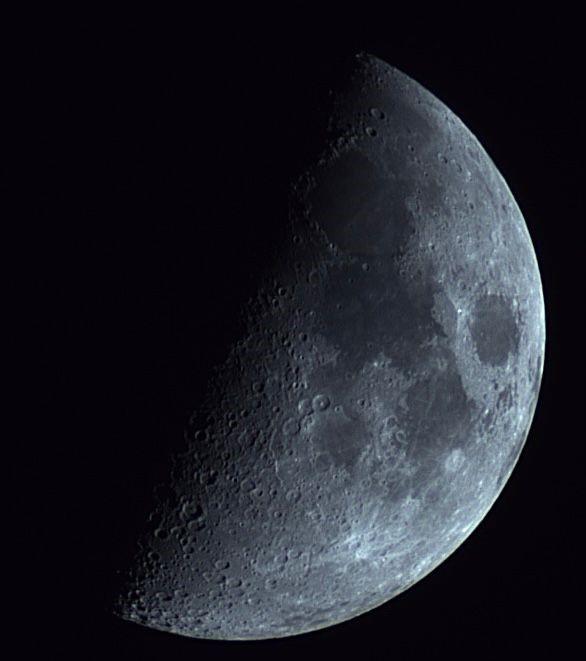Astronomy Every Thursday…
Announcements
Come and see us at Hall Place & Gardens for some Solar Observing – Sunday 7th July 2024
NEVER LOOK AT THE SUN DIRECTLY. Please click here for solar observing safely.
CMHASD Solar Observing at Hall Place & Gardens – Sunday 7th July 2024
11:00 am – 3:00 pm
Face-to-Face Meetings Every Thursday
Face to face meetings every Thursday plus we are live on Zoom*
As a courtesy to others please stay at home and attend via the zoom if you are feeling unwell – coughs, sniffs and sneezes etc.
* zoom will only be available with the lecturer’s consent.
Gallery
A selection of images, photos and observations taken by CMHASD members
Other Images
Sun | Comets | Mercury | Venus | Atmospheric Optics | Meteors | Auroa and NLC | Moon | Minor Planets | Mars | Jupiter | Saturn | Uranus | Neptune | Messier | Caldwell | All Deep Sky | Conjunctions | Transits | Solar Eclipse | Lunar Eclipse | Wide Field |ISS & Space Junk | Exo-Planets
Society News
CMHASD Solar Observing at Hall Place & Gardens – 5th May 2024
NEVER LOOK AT THE SUN DIRECTLY. Please click here for solar observing safely.
On Sunday 5th May 2024 the team from CMHASD set themselves up for the first of our two Solar Observing events at Hall Place & Gardens and what a glorious day it was to be out solar observing.

Members of the public were invited to do some solar observing which was enthusiastically accepted by those who were keen to look at the sun using our scopes. The Sun put on a good display having several complex sunspots for the public to view.
Five telescopes were set up to observe the Sun safely. First; a table-top Celestron Firstscope 76mm Newtonian fitted with a home-made solar filter through which many of the public were able to see the numerous sunspot groups, this was a low budget telescope and easy to use.

There were 3 smart scopes set up; two Seestar S50’s and a Dwarf II. The 2 images of the Sun below were taken by the smart scopes. The first was taken by CMHASD Secretary Dr Mike Rushton using a Dwarf II smart scope and the second taken by member Terry Miles using a Seestar S50 smart telescope. Both images were captured whilst Mike & Terry were helping at Hall Place.

Dwarf II smart telescope (1″ aperture!) 30 x 1/200sec subs at gain 0 with a ND6 Solar filter.

The fifth telescope set up was a Celestron C90 Maksutov Cassegrain telescope, focal length 1250mm, 90mm objective lens (corrector plate) using a 32mm eye piece which gave a full view of the Sun’s disk. This was on a Sky Watcher heavy duty tripod on which was mounted a William Optics wedge on which was mounted a iOptron Sky Guider Pro tracking mount and finally the Mak mounted on top. The Celestron was set up for visual observation only so fitted with a Baader 5ND solar filter, no imaging was done.

Our pitch was on the grass at the end of the path from the main entrance to the gardens, and we were quite close to the hard standing outside the art gallery and café. With the date being chosen to coincide with the Farmers’ Market, we experienced good foot-fall and our flag was prominent for visitors as they arrived.

The Crayford team returns again later in July for our second session but there’s no doubt this first visit to Hall Place for Solar Observing in 2024 was a great success and the Society would like to thank all those members who helped on the day 😀

Thank you also to John Archer, John Howarth, Dr Mike Rushton and Terry Miles for sharing your photos with us.

*** CMHASD will be back at Hall Place on Sunday 7th July 2024 to do some more Solar Observing with the public. Please do come and join us! ***
Our Sun – 21st & 29th April 2024
NEVER LOOK AT THE SUN DIRECTLY. Please click here for solar observing safely.
Two fab images of our Sun taken by member Jim Burchell on the 21st & 29th April 2024. Details of how Jim captured the Sun is on the 1st image. Please note a solar filter was used too.
Sun on 21st April 2024 by Jim Burchell

For comparison; below is the Sun with the Sunspots numbered taken from Spaceweather.com on 21st April 2024.

Ref:https://www.spaceweather.com/archive.php?view=1&day=21&month=04&year=2024
The Sun on 29th April 2024 by Jim Burchell

For comparison; below is the Sun with the Sunspots numbered taken from Spaceweather.com on 29th April 2024.

Ref:https://www.spaceweather.com/archive.php?view=1&day=29&month=04&year=2024
The Sun – 18th April 2024
NEVER LOOK AT THE SUN DIRECTLY. Please click here for solar observing safely.
A super collection of Sun images taken on the 18th April 2024.
The 1st image below was taken by Dr Mike Rushton using a Dwarf II smartscope. Mike took 30 x 1/200sec images which were stacked, gain 0 + solar filter.

For comparison, below is the Sun image from Spaceweather.com on the 18th April and has the Sunspots numbered.

The next 5 images below of the Sun were taken by member Simon Dawes. Details of how Simon acquired his images are on some of the photos.





Double Rainbow
A fantastic image of a double rainbow captured by member Kevin Smith whilst on a walk in Deal, Kent on the 16th April 2024.
At 6.35pm Kevin was walking along the marshes to the West of Deal looking East towards the sea, about 700 metres from the beach when he saw the rainbow and used his Samsung A52s mobile phone to take the photo.
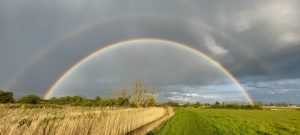
”A double rainbow is a wonderful sight where you get two spectacular natural displays for the price of one.
Surprisingly, this phenomenon is actually relatively common, especially at times when the sun is low in the sky such as in the early morning or late afternoon. The second rainbow is fainter and more ‘pastel’ in tone than the primary rainbow because more light escapes from two reflections compared to one.
The secondary rainbow is also dispersed over a wider area of the sky. It is nearly twice as wide as the primary bow.
A key feature of double rainbows is that the colour sequence in the second rainbow is reversed.
The dark band between the two rainbows is known as Alexander’s band, after Alexander of Aphrodisias who first described it in 200AD.
The band forms because between the deviation angles of the primary and secondary rainbows none of the sunlight is scattered by the raindrops towards the observer giving the band of dark sky.
How are double rainbows formed?
Double rainbows are formed when sunlight is reflected twice within a raindrop with the violet light that reaches the observer’s eye coming from the higher raindrops and the red light from lower raindrops.
This means the sequence of colours is inverted compared to the primary rainbow, with the secondary bow appearing about 10 degrees above the primary bow.” Ref:https://www.metoffice.gov.uk/weather/learn-about/weather/optical-effects/rainbows/double-rainbows
Moon – 15th April 2024
A super image of a Waxing Crescent Moon taken by Dr Mike Rushton on the 15th April 2024. The Moon was 7 days old, 46% illuminated and in the constellation Gemini.
Mike captured the image using a smartscope called a Dwarf II. The photo is a stack of 30 x 1/250 second images at gain 0 but with no filter (except IR cut).
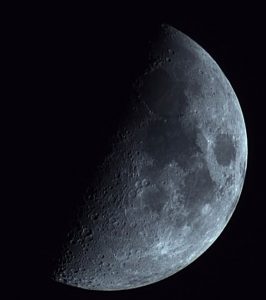
BAA Winchester Weekend 2024
BAA Winchester Weekend
2024 April 12-14
Over the three days 12 CMHASD members were treated to lectures and talks covering a wide variety of astronomical subjects ranging from the BAA Archives to Dark Energy; including two new presentations from CMHASD members Martin Crow, Steve Floodgate & David Grist. To see the whole BAA Winchester Programme click on the link https://britastro.org/wp-content/uploads/2024/03/Winchester-Programme.pdf
This years Alfred Curtis Memorial lecture “The Digital Telescope Concept” was presented by Professor Don Pollacco from the University of Warwick. If you click on the link https://britastro.org/wp-content/uploads/2024/03/Winchester-Bios-Abstracts.pdf you can read the biographies and abstracts of all the speakers and their talks in the order they were given.
On Saturday morning CMHASD member & trustee Martin Crow gave his presentation about the ExoClock Project with regard to how citizen scientists are contributing to ESA’s Aerial Space Mission.


On Saturday afternoon some white light solar observing /imaging was possible through the thin cloud.

NEVER LOOK AT THE SUN DIRECTLY. Please click here for solar observing safely.
Back by popular demand were Eric and Ernie (CMHASD members Steve Floodgate & David Grist) who made an appearance at the BAA members session on Sunday afternoon to promote and drum up support for New Scientist Live at ExCel London at which they and other CMHASD members helped.


Also David Grist is now a fully paid up member of the British Astronomical Association choir….

As night fell, observing had been planned but with cloud cover on both nights two social evenings were had instead 🙂

Thank you to members Diane Clarke & Martin Crow for your help writing this post and to Diane, Martin and Simon Dawes for sharing your photos of the weekend.
Crescent Moon
Two lovely images of a 32 hour old Moon with Earthshine taken by member Richard Bohner from Arizona on the 9th April 2024.
The 1st image of the crescent moon with Jupiter (top left) was taken with an iPhone. The dot to the right of the Moon was an aeroplane.

The 2nd photo of the crescent moon was taken at 7:30 pm using a Canon 6D with 200mm telephoto lens f2.8, 1/20 sec exposure at ISO 3200.

Solar Eclipse – 8th April 2024
NEVER LOOK AT THE SUN DIRECTLY. Please click here for solar observing safely.
The solar eclipse of April 8, 2024, also known as the Great North American Eclipse, was a total solar eclipse visible across a band covering parts of North America, from Mexico to Canada and crossing the contiguous United States. A solar eclipse occurs when the Moon passes between Earth and the Sun, thereby obscuring the Sun. A total solar eclipse occurs when the Moon’s apparent diameter is larger than the Sun’s, blocking all direct sunlight. Totality occurs only in a limited path across Earth’s surface, with the partial solar eclipse visible over a larger surrounding region. Ref:https://en.wikipedia.org/wiki/Solar_eclipse_of_April_8,_2024
Member Richard Bohner took these two superb partial solar eclipse photos at approximately 11:20 am from Cottonwood, in Arizona, USA on the 8th April 2024.
Richard captured the images using a Celestron 8” SCT fitted with a solar filter and a Canon 6D set at 1/30 second exposure and ISO 1600.
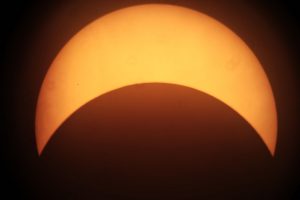
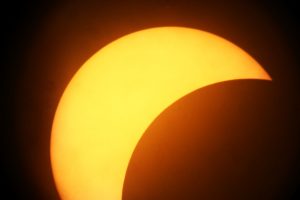
For more information about the total solar eclipse on the 8th April 2024 check out https://en.wikipedia.org/wiki/Solar_eclipse_of_April_8,_2024.
Stunning Solar Halo by Honor Wheeler
NEVER LOOK AT THE SUN DIRECTLY. Please click here for solar observing safely.
Two stunning Solar Halo images taken by member Honor Wheeler on the 14th April 2024 from Winchester.
Honor captured the Solar Halo’s using a Canon M6II fitted with a Samyang 8mm fisheye lens, ISO100, 1/2500’s & 1/3200’s.

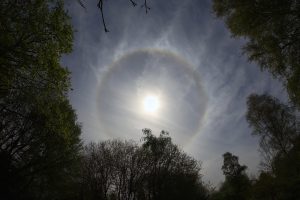
For more information about Solar Halo’s and how they are formed check out https://atoptics.co.uk/blog/atmospheric-halos/.
The Sun – 24th March 2024
NEVER LOOK AT THE SUN DIRECTLY. Please click here for solar observing safely.
A super image of the Sun taken on 24th March 2024 by member Honor Wheeler.
Honor captured the white light image of the Sun using an ED80 Refractor fitted with a solar filter, EQ3-pro Synscan mount, 2x Barlow, Canon M6 II. Exp1/6400s and ISO400.
Below Honor’s image is an image of the Sun on the same day with the sunspots labelled taken from Spaceweather.com.

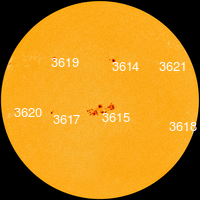
Photo Ref: https://www.spaceweather.com/archive.php?view=1&day=24&month=03&year=2024
Spaceweather.com reported ”Yesterday, the sun produced a solar flare so strong, it took two sunspots to make it. Sunspots AR3614 and AR3615 exploded in tandem on March 23rd (0130 UT), directing their fire straight at Earth. A National Solar Observatory telescope in Australia recorded the double blast.
The explosion from AR3614 (top) was so violent it seemed to rip the fabric of the sun, while AR3615 (bottom) followed very close behind with a less intense blast of its own.
While this may seem like an incredible coincidence, it probably didn’t happen by chance. Researchers have long known that widely-spaced sunspots can explode in tandem. They’re called “sympathetic solar flares.” Occasionally, magnetic loops in the sun’s corona fasten themselves to distant pairs of sunspots, allowing explosive instabilities to travel from one to the other. This has apparently happened to AR3614 and AR3615.
Some sympathetic flares are so much alike, they are considered to be twins. Yesterday’s double-blast was not a perfect twin, but close enough. It shows that the two sunspots are linked, raising the possibility of more double-flares…”
The NASA Solar Dynamics Observatory captured the sequence and it can be viewed in this movie.
The Worm Moon by Honor Wheeler
Three fantastic Full Moon images taken by CMHASD member Honor Wheeler on the 24th March 2024 from North Kent.
This is the first Full Moon of the spring season and appeared on the night of Sunday 24th March and Monday 25th March reaching its peak illumination in the early hours of Monday 25th March 2024.
In March, the Full Moon is also known as the Worm Moon and if it occurs on or after 21st March it is also known as the Paschal Moon, which is used to determine the date of Easter. In some years the Paschal Moon is the Worm Moon as in this year 2024; in others, it’s the Pink Moon (Full Moon in April). The dates for the Paschal Moon range from the 21st March to the 18th April.
Moonrise half risen
Honor used a Canon M6II, Tamron 18-400mm lens set to 400mm, F8.0, exp1/640s and ISO400.
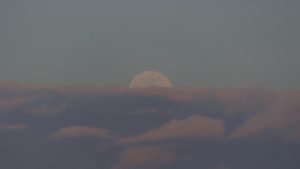
Full Moonrise
Honor used a Canon M6II, Tamron 18-400mm lens set to 400mm, F8.0, exp1/640s and ISO400.
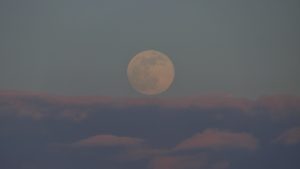
Full Moon and Blossom
The image below is a composite photo of the moon through an Apricot tree in bloom. The first photo was focused on the moon the second focused on the tree then overlayed using snapseed.
Honor used a Canon M6 II, Tamron 18-400mm lens and Tripod.
For the Moon exposure the settings were; lens set to 400mm, F8.0, exp1/3200s and ISO800.
For the tree exposure the settings were; lens set to 400mm, F8.0, exp1.1/3sec and ISO800.

For more information about the March Full Moon check out https://www.almanac.com/content/full-moon-march and https://www.timeanddate.com/astronomy/moon/worm.html
Comet 12P/Pons-Brooks by Jim Burchell
Another fantastic image of Comet 12P/Pons-Brooks captured on the 27th March 2024 by Jim Burchell using his Seestar S50 smart scope. The image consists of 24 x 10 second images stacked.
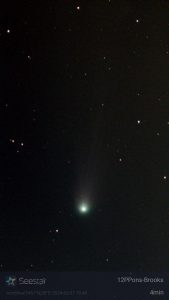
For more information about the comet 12P Pons-Brooks check out https://ras.ac.uk/news-and-press/news/12ppons-brooks-how-and-when-see-devil-comet
Bode’s Galaxy (M81) & the Cigar Galaxy (M82) by Jim Burchell
Bode’s Galaxy also known as Messier 81 (M81) is a grand design spiral galaxy which lies approximately 11.8 million light-years from Earth, with an apparent magnitude of 6.9.
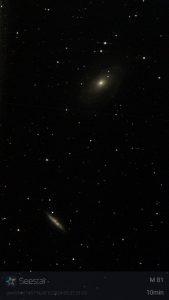
Exoplanet transit of Qatar-9b
One more for the Exoclock project. This time the transit of exoplanet Qatar-9b measured by Simon Dawes and Martin Crow on the same night. Qatar-9 b is a hot Jupiter exoplanet in Ursa Major that orbits a K-type star. Its mass is 1.19 Jupiters, it takes 1.5 days to complete one orbit of its star and is 0.0234 AU from its star. Its discovery was announced in 2019.
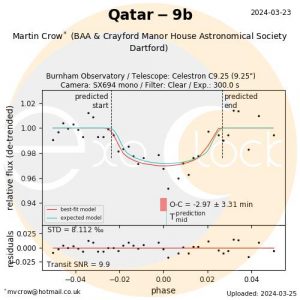

The Moon by Neil Webster
A super selection of Moon images taken by member Neil Webster in March 2024. 22nd March 2024 A Waxing Gibbous Moon, 94.7% illuminated and 12.47days old. 7 frames each 90s x 32fps. Best 20% aligned and stacked in Autostakkert. Processed in PhotoShop. Neil captured the...
Comet 12P/Pons-Brooks by Jim Burchell
Two fantastic images of Comet 12P/Pons-Brooks taken on the 15th & 18th March 2024 by member Jim Burchell. The images were taken using a Seestar S50 smartscope. On both nights Jim had a very small amount of time to capture the comet due to clouds rolling in....
The Sun – 25th Feb 2024 by Jim Burchell
NEVER LOOK AT THE SUN DIRECTLY. Please click here for solar observing safely. A splendid image of the Sun taken on the 25th February 2024 by member Jim Burchell. Jim captured the image using a Seestar S50 smart scope fitted with a solar filter and...
Messier 52 by Diane Clarke
A super image of Messier 52 or M52, also known as NGC 7654 taken by member Diane Clarke on the 6th March 2024 during a brief clear spell in the weather. Messier 52 is also known as the Scorpion Cluster or the Salt & Pepper Cluster and it is an...
ExoPlanet transists 2023 by Simon Dawes
A nice montage of the ExoPlanet transists Simon did in 2023 for the ExoClock...
The Whirlpool Galaxy (M51a) by Diane Clarke
A great image of the Whirlpool Galaxy, also known as Messier 51a (M51a) or NGC 5194 and its companion NGC 5195 taken by member Diane Clarke on the 3rd March 2024. The Whirlpool Galaxy was the first galaxy to be classified as a spiral galaxy. ...
Lunar Clair-obscur Effects – French for “light” (clair) and “shadow” (obscur)
Some fantastic images showing two ‘Clair-obscur’ effects visible on the surface of the Moon taken by member Jim Burchell on the 19th & 20th January 2024. Clair-obscur effects are revealed when light and shadow interact with the Moon’s...
The Orion Nebula by Jim Burchell
A lovely image of the Orion Nebula (Messier 42/M42) taken by Jim Burchell on the 23rd February 2024 using a ZWO SeeStar S50 smart scope. The image is a stacked image containing 12 minutes of 10 second images. Jim said ”Considering the Moon phase was 97%...
The Orion Nebula (M42) by Dr Mike Rushton
A superb image of the Orion Nebula (Messier 42/M42) taken by Dr Mike Rushton on the 3rd March 2024. Mike acquired the image using a Dwarf2 telescope from DWARFLAB and took 400 subframes of 10 secs which was then processed in...
The Sun by Jim Burchell – 1st March 2024
NEVER LOOK AT THE SUN DIRECTLY. Please click here for solar observing safely. Super image of the Sun taken by member Jim Burchell on the 1st March 2024. The image was taken using a Pentax KP body set at Iso 200 & 1/400 sec, attached to...








